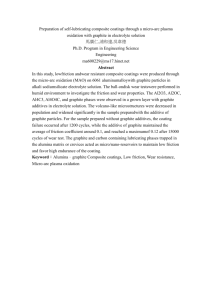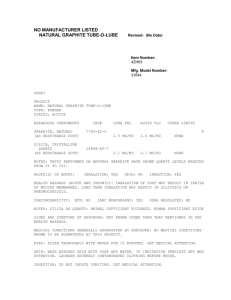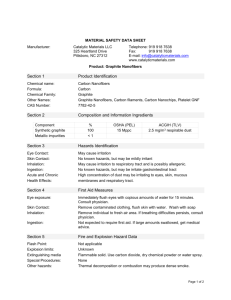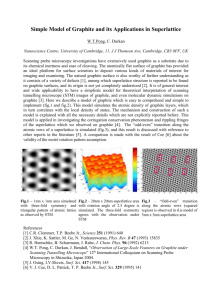Preparation of functionalized graphene oxide - Wiley-VCH
advertisement
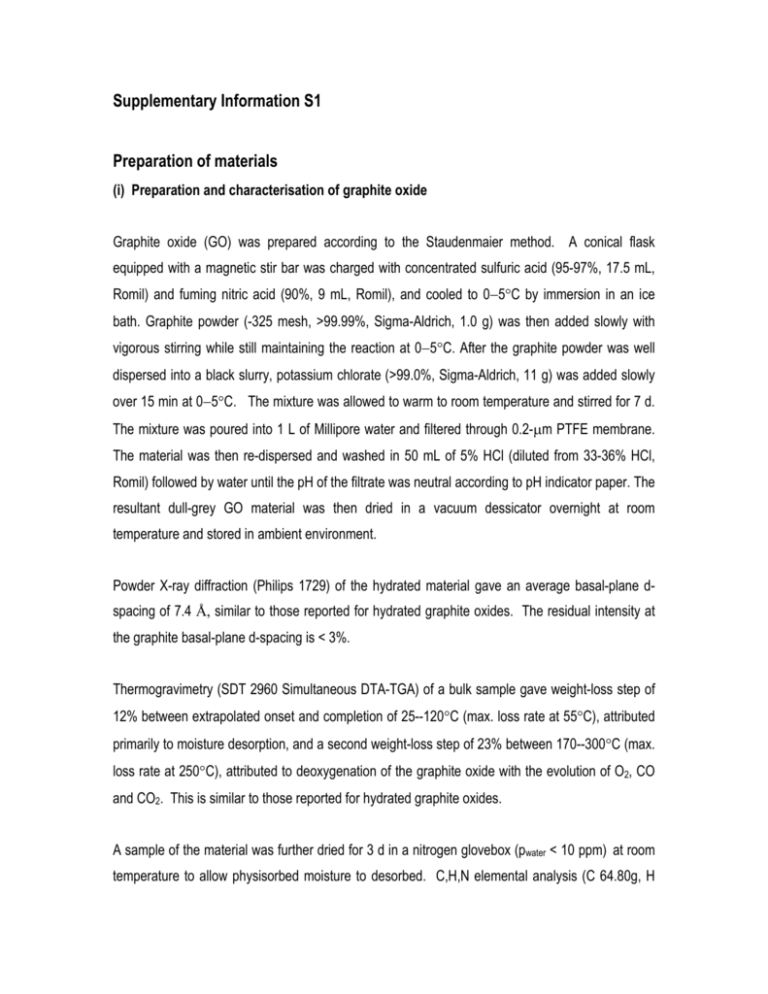
Supplementary Information S1 Preparation of materials (i) Preparation and characterisation of graphite oxide Graphite oxide (GO) was prepared according to the Staudenmaier method. A conical flask equipped with a magnetic stir bar was charged with concentrated sulfuric acid (95-97%, 17.5 mL, Romil) and fuming nitric acid (90%, 9 mL, Romil), and cooled to 0−5°C by immersion in an ice bath. Graphite powder (-325 mesh, >99.99%, Sigma-Aldrich, 1.0 g) was then added slowly with vigorous stirring while still maintaining the reaction at 0−5°C. After the graphite powder was well dispersed into a black slurry, potassium chlorate (>99.0%, Sigma-Aldrich, 11 g) was added slowly over 15 min at 0−5°C. The mixture was allowed to warm to room temperature and stirred for 7 d. The mixture was poured into 1 L of Millipore water and filtered through 0.2-μm PTFE membrane. The material was then re-dispersed and washed in 50 mL of 5% HCl (diluted from 33-36% HCl, Romil) followed by water until the pH of the filtrate was neutral according to pH indicator paper. The resultant dull-grey GO material was then dried in a vacuum dessicator overnight at room temperature and stored in ambient environment. Powder X-ray diffraction (Philips 1729) of the hydrated material gave an average basal-plane dspacing of 7.4 Å, similar to those reported for hydrated graphite oxides. The residual intensity at the graphite basal-plane d-spacing is < 3%. Thermogravimetry (SDT 2960 Simultaneous DTA-TGA) of a bulk sample gave weight-loss step of 12% between extrapolated onset and completion of 25--120°C (max. loss rate at 55°C), attributed primarily to moisture desorption, and a second weight-loss step of 23% between 170--300°C (max. loss rate at 250°C), attributed to deoxygenation of the graphite oxide with the evolution of O2, CO and CO2. This is similar to those reported for hydrated graphite oxides. A sample of the material was further dried for 3 d in a nitrogen glovebox (pwater < 10 ppm) at room temperature to allow physisorbed moisture to desorbed. C,H,N elemental analysis (C 64.80g, H 1 2.04g and O was obtained by difference) gave the empirical formula C2.0O0.77H0.75. Further oxidation can produce the fully oxidised material (C2.0O1.00H0.5), which is undesirable here. (ii) Preparation and purification of exfoliated ODA-functionalised graphite oxide (ODA-GO) sheets In a typical preparation, a mixture of 10 mg of GO and 100 mg of octadecylamine (ODA, 97% purity, Sigma-Aldrich) and with/without 60 μL 1,3-diisopropylcarbodiimide (DIC, 99% purity, SigmaAldrich) was mixed with 5 mL of dichlorobenzene (99.8% purity, Romil) in a borosilicate glass reaction vial, purged with N2 and heated with intermittent sonication to 80°C for 24 h under N2 to give a homogeneous black dispersion. This dispersion was stable for more 6 months at room temperature. It contained the desired functionalized ODA-GO single sheets in suspension, contaminated with a small quantity of un-exfoliated materials which give large particles (up to micron-sized), nanoparticles (diameter 1-2 nm), as well as large amounts of excess ODA and DIC. Figure S1.1 shows that AFM image of an ODA-GO film with particulates contamination. This film was spin-coated using ODA-GO dispersion before repeated centrifugation and re-dispersion purification step. 125nm Figure S1.1 AFM image of an ODA-GO film spin-coated from unpurified ODA-GO dispersion. To purify the ODA-GO single sheets, in a typical procedure, a 0.25 mL aliquot was extracted from this mother liquor and homogeneously mixed with 5 mL of THF (>99.9% purity, HPLC grade, 2 Sigma-Aldrich) and sonicated briefly. To separate out the un-exfoliated materials, this mixture was centrifuged at 8000 revolutions per min (8000 rpm, corresponding to 5580 g) for 1 h. The aggregated particles were centrifuged out as the precipitate (i.e., centrifugate), while the ODA-GO single sheets remained in suspension in the dark supernatant together with nanoparticles and excess ODA and DIC. To purify these ODA-GO single sheets from the nanoparticles and excess ODA and DIC, this supernatant was extracted and mixed with 5 mL of ethanol (>99.8% purity, HPLC grade, SigmaAldrich) to cause aggregation of the ODA-GO sheets. The precipitated ODA-GO was collected by centrifuge at 8000 rpm for 1 h. The colourless supernatant which contained dissolved ODA and DIC was discarded, and a second portion of 5 mL of ethanol was added to the black centrifugate of ODA-GO. To wash this thoroughly, the mixture was sonicated for 5 min and then centrifuged at 8000 rpm for 0.5 h to collect the ODA-GO, discarding the supernatant. A third portion of 5 mL of ethanol was added, and the washing repeated once more, discarding the supernatant. Finally 1 mL toluene was added to the centrifugate, sonicated for 5 min, and centrifuged at 8000 rpm for 1 h. The centrifugate was collected and the light-coloured supernatant was discarded. A second portion of 1 mL of toluene was added to the centrifugate and the washing repeated once more, discarding the colorless supernatant. The desired ODA-GO was then collected as the black centrifugate. To prepare the ODA-GO dispersion in THF, 1.0 mL of THF was added to this centrifugate and sonicated for 1 min to give a black dispersion. This dispersion was stable for more 6 months (i.e., no precipitation) when kept in an amber vial in ambient (see Fig. 1a inset). This dispersion could be spin-coated or ink-jet printed to give pure films of ODA-GO (see Figs. 1c and d). These films are free from particulates, ODA deposits (which appear as dendritic islands 3.2-nm thick corresponding to a bilayer, which grows over time), or nanoparticles, which are found in imperfectly purified materials. 3 Solution-state UV-vis absorption spectrometry typically gave a concentration of 0.3−0.4 mg/mL. This was calibrated against known ODA-GO concentrations established by microgravimetric analysis. 1.0 mg/mL dispersion in THF gave an absorbance of 1.0 through 1.0-cm path-length at 900-nm wavelength. The recovered ODA-GO was therefore 0.3−0.4 mg. Fourier-Transform Infrared (FTIR) spectroscopy of ODA-GO dispersed in KBr discs gave an ODAto-GO weight ratio of 0.62 ± 0.02, based on the integrated absorption intensity of the CH2 νs and νas bands at 2850cm-1 and 2920cm-1 respectively. Therefore the theoretical yield is 0.80 mg. The recovered yield of purified ODA-GO thus corresponds to 40−50%, which is remarkably high. Together with the empirical formula of the GO, we can then deduce from the experimental ODA-toGO weight ratio a grafting density of approximately one octadecyl chain on every 24 carbon atoms (corresponding to 12 hexagonal cells) in the GO basal plane. Therefore the functionalisation occurs also on the faces of the GO in addition to the expected functionalisation along the perimeter of the sheets. This is proven by direct scanning tunneling microscopy imaging. 4 Supplementary Information S2 X-ray photoelectron spectroscopy of ODA-GO The evolution of the chemical structure of the ODA-GO single-sheet films was monitored by UPS and XPS. Thin films of the ODA-GO spin-cast on native silicon oxide (effective thickness by tapping mode AFM is ca. 15Å), corresponding to a monolayer film of single-sheets. The samples were then baked at various Tanneal between 120–300°C for 10 min in a nitrogen glovebox, and transferred quickly to an ESCALAB MKII spectrometer operating at a a base pressure better than 10–9 mbar. The films were excited with He I UV photons (21.21 eV) with a constant sample bias of –10.00 V. The electrons photoemitted normal to the film were analysed by a 200-mm-diameter concentric hemispherical analyser with constant pass energy of 5.0 eV, corresponding to an energy resolution of 0.2 eV. The films were then excited with MgKα1,2 X-ray photons (1253.6 eV) with the sample grounded. The electrons photoemitted normal to the film were analysed as before with constant pass energy of 20 eV for core level spectra (energy resolution, 0.7 eV). Figure S2.1 shows the curve-fitted C1s core-level XPS spectra of these ODA-GO nanosheets across the insulator-to-semimetal transition. The fitted binding-energy (BE) components and their assignments are given in Table S2.1. The hydrocarbon sp3-hybridized C1s and graphene sp2hybridized C1s components lie at 285.0–286.2 eV. Small differences between the sp3 and sp2 carbons (typically 0.25−0.5 eV)[1] cannot be resolved. A progression of peaks is used to model the vibrational progression,[1] secondary chemical shift effects,[1] as well as asymmetry in these line shapes. Chemical bonding to oxygen leads to large primary chemical shifts of the carbon C1s BE: typically +1.2 to 1.8 eV for C−O, +2.8 to 3.0 eV for C=O, and +3.8 to 4.3 eV for C(=O)−O which are 1 therefore readily distinguishable.[1, 2] The 287.2-eV BE component is chemically distinct and characteristic of single oxygen-bonded carbon atoms in both epoxide and β-dihydroxy groups. The chemical shift found here (+2.2 eV, relative to 285.0 eV) is higher than for isolated C−O groups due to secondary (or β) shift effects.[1] The full-width-at-half-maximum (fwhm) of this component (1.8 eV) is significantly larger than that of the unoxidised components (1.2−1.4 eV) due to inhomogeneous broadening. The ratio of its integrated intensity to the sum of the components at 285.0–286.2 eV, after correcting for the alkyl hydrocarbon contribution, independently measured in fourier-transform infrared spectroscopy (FTIR), gives the fraction of oxidised carbon. Comparison of this fraction with microanalysis results suggests that the oxygen species are predominantly in the hydroxy form (3:1) in the as-deposited materials. The fraction of sp2 carbons is then obtained as the difference of this ratio from unity, which increases from 0.5 to 0.8, and plotted in the inset of Figure 2b. These sp2 carbons have one π electron each in the pz orbitals which reside in extended π conjugation, according to the FTIR and UPS measurements. The component at 288.8 (and 290.4 eV) is assigned to a shake-up satellite rather than the next higher-oxidized carbon because its apparent chemical shift (+3.8 eV) is significantly larger than for C=O even after taking into consideration possible β shift effects. The overall intensity associated with these components increases with annealing from 0.05 to 0.08, as expected of the behaviour of shake-up contributions with increasing graphenisation. FTIR (see Supplementary Information S3) confirms that the C=O concentration is below 0.5% of the basal-plane carbon atoms. 2 Tanneal = 120°C Tanneal = 200°C 280 285 290 Binding energy (eV) 295 Photoemission intensity Photoemission intensity Photoemission intensity Tanneal = 150°C 280 285 290 Binding energy (eV) 295 280 285 290 Binding energy (eV) 295 Tanneal = 300°C Photoemission intensity Photoemission intensity Tanneal = 250°C 280 285 290 Binding energy (eV) 295 280 285 290 Binding energy (eV) 295 Figure S2.1 Curve-fitted C1s core-level spectra of ODA–GO monolayer-thick films deposited on native silicon oxide wafers and annealed to the indicated temperatures for 10 min each. Binding energies are referenced to the sample Fermi level defined to be 0.0 eV. Spectral energy resolution is 0.7 eV. No sample charging was observed on account of these ultrathin films on native silicon oxide. Sample Chemical environments alkyl and aromatic carbons 120°C 150°C 200°C 250°C 300°C 285.0 eV 0.55 (1.4) 0.59 (1.4) 0.67 (1.25) 0.73 (1.25) 0.72 (1.2) 285.6 eV 0.15 (1.4) 0.12 (1.4) 0.04 (1.25) 0.00 0.00 286.2 eV 0.00 0.00 0.12 (1.25) 0.09 (1.5) 0.10 (1.2) epoxy C−O and β-dihydroxy C−OH 287.2 eV 0.25 (1.8) 0.24 (1.8) 0.11 (1.8) 0.10 (1.8) 0.10 (1.8) shake-ups 288.8 eV 0.03 (1.8) 0.04 (1.8) 0.03 (1.8) 0.06 (1.8) 0.06 (1.8) 290.4 eV 0.02 (1.8) 0.01 (1.8) 0.03 (1.8) 0.02 (1.8) 0.02 (1.8) Table S2.1 Chemical environments of the carbon atoms given as fractions, obtained by Gaussian curve-fitting of the C1s core-level spectra of ODA-GO monolayer-thick films after linear background subtraction. The optimised full-width-at-half-maximum (in eV) is given in brackets. References [1] Beamson, G. and Briggs, D., in High resolution XPS of organic polymers, John Wiley & Sons Ltd, Chichester, 1992. [2] Briggs, D. and Seah, M. P., in Practical surface analysis, John Wiley & Sons Ltd, Chichester, 1983. 3 Supplementary Information S3 Fourier-transform infrared spectroscopy (mid-infrared region) Figure S2.1 shows the Fourier-transform infrared spectroscopy of ODA-GO dispersed in highquality non-scattering KBr discs. The doublet at 2850 cm―1 and 2920 cm―1 corresponds to symmetric νsCH2 and asymmetric νasCH2 of the alkyl chains that are grafted on the carbon basal plane. The amide νsNH vibration expected at 3300 cm–1 is not present. Also, the 1650-1750 cm―1 region does not have show a strong νsC=O band. Using empirical Iνs C=O / Iνs CH2 vibrational absorption cross-section ratios obtained from reference compounds (nylon 12 and azacyclotridecan-2-one), we determined the upper limit of the concentration of C=O groups to be 0.5% of basal-plane carbons. This is consistent with our XPS analysis which indicates the absence of higher-oxidised species such as C=O and COOH. Therefore, the carbon basal plane after oxidation consists of mainly β-dihydroxy C-OH and C-O epoxy groups. For comparison, the ODA alkyl-chain concentration is 4% of basal-plane carbons. Therefore these chains are grafted onto the GO not through amide bonds as might be expected, but through direct linkage perhaps through SN2 nucleophilic displacement of epoxy leaving group. The doublet at 2361 cm―1 and 2337 cm―1which only appears after sequent higher temperature annealing is due to CO2 released during graphenisation. 1 2.5 -log(Transmittance) 2.0 2920 (νasCH2) 2850 (νsCH2) 2351 (νasCO2) 120ºC 150ºC 200ºC 250ºC 300ºC 1.5 1.0 3441 (νOH) 0.5 1.0mg ODA-GO in 200mg KBr disc (12.7-mm dia.), annealed 10 min in N 2 0.0 4000 3500 3000 2500 2000 Wavenumber (cm -1) Figure S2.1 1500 1000 Fourier-transform infrared spectroscopy of an ODA-GO sample dispersed in KBr discs (1.0 mg ODA-GO in 200 mg KBr) with different annealing temperature. The sample was annealed at the stated temperature for 10 min in nitrogen. 2 Supplementary Information S4 Absorption spectra of isotropically distributed GO and graphite In the N2 glovebox, 2.0 mg of GO (previously dried at room temperature for several days in the N2 glove box) was mixed with 200 mg of analytical grade KBr (previously dried at 120°C), finelyground to a powder, and then baked for 10 min at 120°C. This mixture was then loaded into a pellet maker, and pressed to give an optically clear (but very black) KBr disc of diameter 12.7 mm. The 5000–800 cm–1 wavenumber region was acquired using IR source, KBr beam-splitter and liquid-nitrogen-cooled MCT detector; the 10000–5000 cm–1 region was acquired using white-light tungsten source, quartz beam-splitter and liquid-nitrogen-cooled MCT detector, both in nitrogenpurged Nicolet 8700 FT-IR spectrometer. The 35000–9000 cm–1 region was acquired by lock-inamplifier technique using a quartz-tungsten halogen source, monochromator (Cornerstone 260), and silicon detector under nitrogen purge. Lock-in detection had to be used because of very high absorbance in this region (5–8 absorbance units) due to the strong π electronic absorption. The absorption cross-section per carbon atom was computed using σ = A ⋅ ln 10 ρ where ρ is the number of basal-plane carbon atoms per unit cross-sectional area of the KBr disc. ρ is known accurately from the amount of GO added (2.0 mg) to the KBr, the diameter of the pellet (12.7 mm), and the chemical formula of the GO (C2.0O0.77H0.75, which gave a formula weight of 37.1 g mol–1). The results are consistent with independent UV-Vis solution-state measurements of ODA-GO dispersed at known concentrations in THF, adding confidence to these measurements. The pellet was then annealed at the indicated temperatures for 10 min each, in the N2 glovebox, and re-measured. The absorption cross-section per carbon atom of graphite was computed from the complex refractive index spectrum of graphite (Figure S4.1) using σ = α ⋅ V where V is the atomic volume of carbon in graphite, and α is the inverse absorption length is given by α = 2 ⋅ 4π ⋅ν ⋅ k with k as 3 the imaginary refractive index, ν is the wavenumber and prefactor 2/3 takes into account isotropic averaging over all orientations. 10.0 8.0 n_in-plane k_in-plane n, k 6.0 4.0 2.0 0.0 1000 10000 Wavelength (nm) Figure S4.1 Complex refractive index spectrum of graphite for electric field E ┴ c -axis of graphite. Values below 2000 nm were directly taken from Ref1 and above 2000 nm were from our optical modeling of the reflectivity data of a HOPG presented in Ref2. References [1] Taft, E. A., Philipp, H. R., Phys. Rev., 1965, 138, A197. [2] Ugawa, A., Rinzler, A. G., Tanner, D. B., Phys. Rev. B., 1999, 60, R11305.

